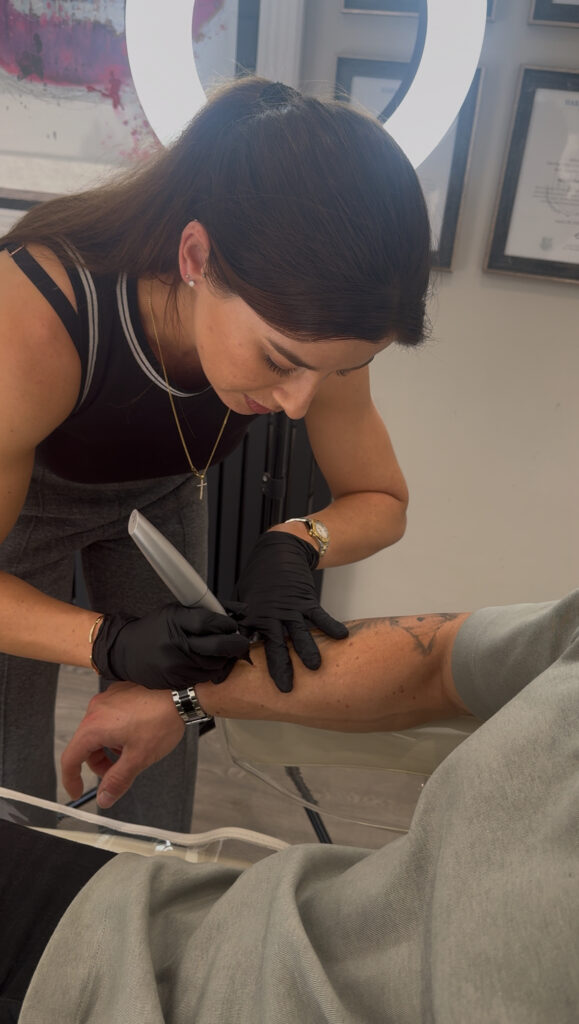Budletts Farm House, Uckfield, TN22 2EA

The term ‘cryotherapy literally means
‘treatment using low temperature’ and refers to the removal of surface skin lesions by freezing them. The most commonly used freezing agent or product is liquid nitrogen.
varies per patient
15-30 minutes
Full accurate price will be given on the day of treatment
Most people will only need the 1 treatment but may require a follow up appointment subject to the size of lesion
Approximately 6-10 weeks for most patients
No downtime
Same day
Results will last all the time for most patients
HOW IT WORKS
Following your consultation or if you have already decided on your treatment, book your treatment online, full out a contact form or give our team a call.
Liquid nitrogen is the liquid state of nitrogen gas, which occupies 78% of the air we breathe. It is extremely cold, having a boiling point of minus 196°C. It can freeze and destroy any part of the skin that it comes into contact with. It is necessary to store and transport liquid nitrogen in special flasks.
Many abnormal areas of skin (lesions) can be treated with cryotherapy. This includes non-cancerous (benign) lesions. It is most commonly used to remove areas of sun-damaged skin found predominantly on sun-exposed parts of the body. It is also used to treat viral warts, seborrhoeic keratoses, and other benign lesions.
Occasionally, your dermatologist may suggest using cryotherapy to low grade skin cancers such as basal cell carcinoma.
Cryotherapy is often carried out by a healthcare practitioner at an out-patient consultation. The liquid nitrogen is usually applied to the skin by using a spray gun, a metal probe, or a cotton bud.
Cryotherapy does not normally require a local anaesthetic as pain is usually mild and short lived (although this does vary between individuals and according to the body site being treated). The procedure itself lasts a matter of seconds; the precise time depends on the thickness and size of the lesion. The frozen skin becomes white and takes one to two minutes to thaw back to normal skin temperature. Your doctor may suggest that the process be repeated once the skin has thawed.
Treatment is likely to produce a reaction similar to a burn. The skin may look red, swell, or blister. Redness may not be apparent in people with darker skin. After a few days, a scab will form, and this will take a few weeks to fall off depending on the site (occasionally a little longer, especially on the legs where healing is slow).
Aim to keep the treated areas dry for 24 hours. You can then wash the areas gently and pat dry with a soft towel or tissue. A petroleum jelly (such as Vaseline®) can be applied daily to help the area heal and prevent crusting.
It is important not to pick the scab as this Will encourage scarring. A dressing or plaster is not usually necessary but may be advisable it the treated area is likely to be knocked or rubbed by clothing.
In most cases, the treated area will eventually look like normal skin, although scarring and changes in skin colour are possible, and rarely ulceration (broken down areas of skin), particularly on the lower legs.
Immediate side effects:
• Pain – cryotherapy is usually well-tolerated but can sometimes be painful if a deep freeze has been necessary (i.e., to treat a basal cell carcinoma). This discomfort can occur both at the time of treatment and for a variable time thereafter.
Painkillers (such as paracetamol) taken for the first 24 hours may relieve the discomfort; also taking a painkiller an hour or so prior to the anticipated treatment may reduce the discomfort.
• Swelling and redness – this is a normal immediate response to freezing the skin and usually settles after two to three days. For a short while the treated area may ooze a little watery fluid. Cryotherapy close to the eyes may induce prominent puffiness of the lower eyelids which settles within days.
Blistering – this is also common, and blisters settle after a few days as the scab forms. Some people blister more easily than others.
Occasionally the blisters may become filled with blood; this Is harmless. Blisters should only be punctured after seeking medical advice.
• Infection – uncommonly, infection can occur, resulting in increased pain and pus: this may require an antiseptic cream or oral antibiotic therapy from the healthcare practitioner who performed the treatment, or your GP.
Subsequent side effects:
• Scarring – rarely, a scar may form.
You may be left with a pale mark or a flat white scar, regardless of your skin colour.
• Hypertrophic/Keloid scarring – very rarely a raised scar can form following treatment with cryotherapy which appears as a rounded, hard growth on the skin.
These are harmless lesions, more common in darker skinned individuals.
Pigmentation changes – the skin at and around the treatment site may lighten or darken in colour,
especially in darker-skinned people.
This usually improves with time but may be permanent.
• Numbness – if a superficial nerve is frozen, it may result in numbness of the area of skin supplied by that nerve. Normal feeling usually returns within a matter of months.
• Recurrence – treatment may fail, or the growth may recur. You might need a repeat treatment or a different treatment.